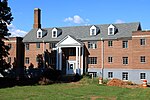Apartment Building on Windsor Avenue and Brunswick St.

Apartment Building on Windsor Avenue and Brunswick St., also known as the Windsor Avenue Apartment Building, is a historic apartment building located in the Raleigh Court neighborhood of Roanoke, Virginia. It was built in 1928, and is a two-story, U-shaped Tudor Revival style apartment building constructed of stone, brick, half timbering, and stucco. The building enclosed a courtyard plaza with stone paved sidewalks, stone walls (2 contributing structures), historic post lights and two decorative pools with waterfall (2 contributing objects). Also on the property is a contributing detached garage.It was listed on the National Register of Historic Places in 2010.
Excerpt from the Wikipedia article Apartment Building on Windsor Avenue and Brunswick St. (License: CC BY-SA 3.0, Authors, Images).Apartment Building on Windsor Avenue and Brunswick St.
Brunswick Street Southwest, Roanoke West End
Geographical coordinates (GPS) Address Nearby Places Show on map
Geographical coordinates (GPS)
| Latitude | Longitude |
|---|---|
| N 37.263055555556 ° | E -79.980277777778 ° |
Address
Brunswick Street Southwest 1638
24015 Roanoke, West End
Virginia, United States
Open on Google Maps






